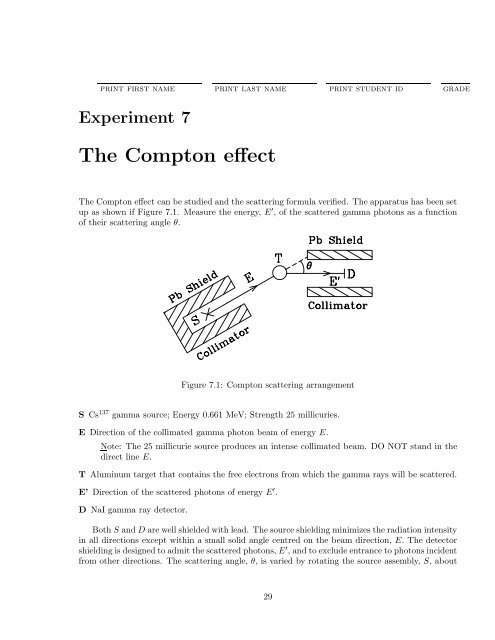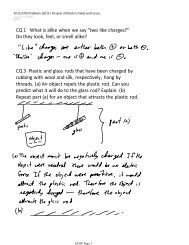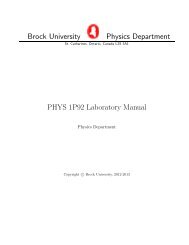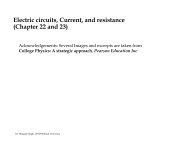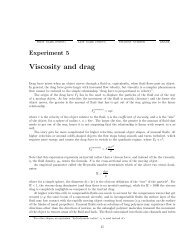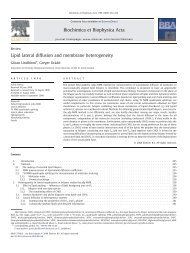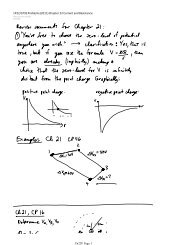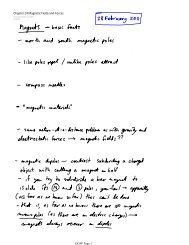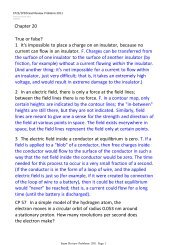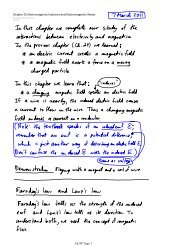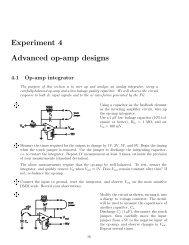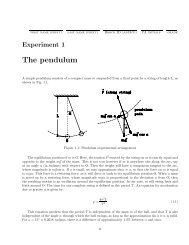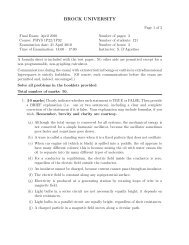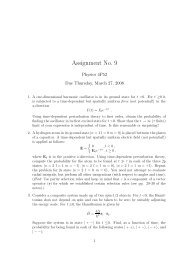7.The Compton Effect
7.The Compton Effect
7.The Compton Effect
Create successful ePaper yourself
Turn your PDF publications into a flip-book with our unique Google optimized e-Paper software.
print first name print last name print student id grade<br />
Experiment 7<br />
The <strong>Compton</strong> effect<br />
The <strong>Compton</strong> effect can be studied and the scattering formula verified. The apparatus has been set<br />
up as shown if Figure 7.1. Measure the energy, E ′ , of the scattered gamma photons as a function<br />
of their scattering angle θ.<br />
Figure 7.1: <strong>Compton</strong> scattering arrangement<br />
S Cs 137 gamma source; Energy 0.661 MeV; Strength 25 millicuries.<br />
E Direction of the collimated gamma photon beam of energy E.<br />
Note: The 25 millicurie source produces an intense collimated beam. DO NOT stand in the<br />
direct line E.<br />
T Aluminum target that contains the free electrons from which the gamma rays will be scattered.<br />
E’ Direction of the scattered photons of energy E ′ .<br />
D NaI gamma ray detector.<br />
Both S andD arewell shieldedwithlead. Thesourceshieldingminimizes theradiation intensity<br />
in all directions except within a small solid angle centred on the beam direction, E. The detector<br />
shieldingisdesignedtoadmitthescattered photons, E ′ , andtoexcludeentrancetophotonsincident<br />
from other directions. The scattering angle, θ, is varied by rotating the source assembly, S, about<br />
29
the target position, T. To measure E ′ use the energy calibration that you made earlier. Check it<br />
out if there has been an interval between laboratory sessions!<br />
Accumulate the pulse height spectrum of the scattered photons as a function of the scattering<br />
angleandsodetermineE ′ (θ). The<strong>Compton</strong>formulaisusuallygivenintermsofincidentwavelength<br />
λ and scattered wavelength λ ′ :<br />
λ ′ −λ = h<br />
m 0 c (1−cosθ).<br />
Show that in terms of photon energies E ′ and E this formula becomes<br />
1<br />
E ′ − 1 E = 1<br />
m 0 c 2 ·(1−cosθ)<br />
Plot your experimental data as 1/E ′ versus (1−cosθ) and from the results determine E and<br />
the electron rest mass energy m 0 c 2 .<br />
The minimum value of the scattering angle θ at which the <strong>Compton</strong> scattering energy shift<br />
is observable will be determined by the energy resolution of the detector and the effectiveness of<br />
the lead collimator which defines the solid angle of emergence of the cesium photon beam. If the<br />
scattering angle is made too small, the direct shine of the cesium gamma photons into the detector<br />
will completely mask the small <strong>Compton</strong> energy shift. Only a small fraction of the photons are<br />
scattered in the target. The intensity of the scattered beam is much less than that of the incident<br />
beam. The recording time required to obtain a satisfactory spectrum may be many minutes. If<br />
there is any direct shine into the detector the recording time will be seconds rather than minutes!<br />
30


